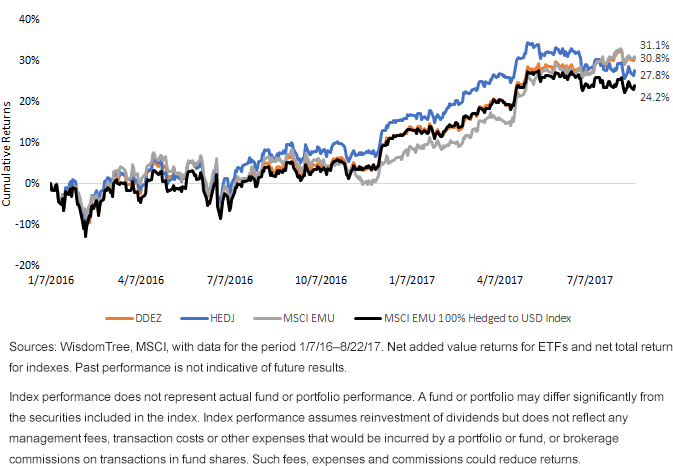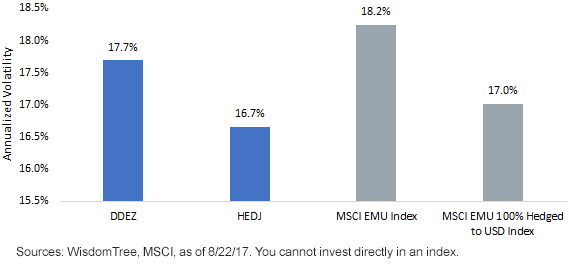Time to Get Bullish on the Euro? Why We Would Incorporate a Dynamic Approach


One of the big stories this year has been the weakness in the U.S dollar after a strong run in the second half of 2016. A confluence of factors is affecting the euro—from politics in the U.S. to monetary policy shifts that may occur later this year in the eurozone.
This has caused a shift in the attention of investors, from a focus on currency-hedged strategies that have the goal of isolating the equity market returns alone to “double decker” strategies that add currency risk on top of the equity returns.
Strategically, I believe there is a case to hold hedged strategies over the long run to reduce the uncertainty that comes with currencies. Sure, the euro is on a hot streak at the moment—but this is far from a sure sign to add value always and forever as unhedged strategies dictate. The euro’s volatility over the last 20 years has been 10%—and the average annual move in either direction plus or minus 9%.1
Is now the time to turn more tactically bullish on the euro?
The increased flows to unhedged European stock exposures mean—whether intentionally or unintentionally—investors are taking on more euro risk. Instead of always being long the euro on top of equities, for those who wish to add in currency risk, WisdomTree has been advocating a dynamic factor model to determine how much risk to hedge or keep exposed.
Our currency factor model uses three factors to determine the hedge ratio: interest rate differentials, value and momentum.
- The interest rate differentials will suggest staying hedged the euro for some time—and would largely require the European Central Bank to hike rates to higher levels than the U.S. Federal Reserve (Fed). This will mandate that WisdomTree’s dynamic hedged Indexes offer a minimum one-third hedge ratio on the euro for an extended period. Our research has shown that when you were paid to hedge like you are today, that interest rate differential on average offset any gains that came in the currencies—this was one of strongest factors in our research.
- Momentum: The reason that many have become more bullish on the euro is that it just started appreciating. Our momentum model evaluates the 10-day moving average of currencies compared with the 240-day moving average. This signal is currently unhedged with the euro’s positive momentum and will remain there until the 10-day moving average crosses back below the 240-day moving average.
- Value: Our fair value model for the euro reduced the hedge ratio earlier this year. The euro crossed below our 20% undervalued threshold on a purchasing power parity basis and will remain unhedged on that model for some time.
We launched the WisdomTree Dynamic Currency Hedged Europe Equity Fund (DDEZ), in January 2016. Over the ensuing period, it has outperformed both the fully hedged index from MSCI by approximately 660 basis points (bps) cumulatively and lagged the unhedged index by less than 40 bps cumulatively.
The WisdomTree Europe Hedged Equity Fund (HEDJ), which focuses on the exporters of Europe, was able to outperform the MSCI EMU (European Economic and Monetary Union) 100% Hedged to USD Index by 362 bps—this performance was due to its stock selection and weighting compared to a market cap index. While many have looked at this as a tactical play on Europe, we still advocate this as a core position of quality European stocks that have lower volatility than traditional unhedged European strategies.
Cumulative Returns (1/7/16–8/22/17)

European Equity Returns (1/7/2016 - 8/22/2017)

For definitions of terms in the chart, visit our glossary.
From a volatility perspective, the hedged indexes, which are more like a pure equity strategy compared to the “double decker” equity plus currency strategies, will show lower volatility. Looking at annualized daily volatility levels, because we have a short period of the live dynamic hedged index, you can see the differentials in volatility.
Annualized Volatility (1/7/16 - 8/22/17)

Click here for DDEZ and HEDJ standardized performances.
The euro has contributed to returns for international investors this year, but this may not always be the case. I remember when many contrarians looked at the flows going to hedged strategies and suggested smarter investors should “go the other way.” I’d argue that to lean against the vast tide today would be to move back toward hedged indexes for the eurozone and not in the double-decker funds. But if you think one can add value in rotating the hedge ratios and do not want to make a subjective determination, WisdomTree believes its quantitative and rules-based factor model will likely add value over time compared to both hedged and unhedged offerings.
1Volatility measured as the standard deviation of daily returns for the period 4/30/1998–8/22/2017. Average annual move measured for the period 12/31/1998–12/30/2016.
Important Risks Related to this Article
Investments focused in Europe increase the impact of events and developments associated with the region, which can adversely affect performance.
HEDJ: There are risks associated with investing, including possible loss of principal. Foreign investing involves special risks, such as risk of loss from currency fluctuation or political or economic uncertainty. Investments in currency involve additional special risks, such as credit risk and interest rate fluctuations. Derivative investments can be volatile, and these investments may be less liquid than other securities, and more sensitive to the effect of varied economic conditions. As this Fund can have a high concentration in some issuers, the Fund can be adversely impacted by changes affecting those issuers. Due to the investment strategy of this Fund, it may make higher capital gain distributions than other ETFs.
DDEZ: There are risks associated with investing, including possible loss of principal. Foreign investing involves special risks, such as risk of loss from currency fluctuation or political or economic uncertainty. The Fund invests in derivatives in seeking to obtain a dynamic currency hedge exposure. Derivative investments can be volatile, and these investments may be less liquid than other securities, and more sensitive to the effects of varied economic conditions. Derivatives used by the Fund may not perform as intended. A Fund that has exposure to one or more sectors may be more vulnerable to any single economic or regulatory development. This may result in greater share price volatility. The composition of the Index underlying the Fund is heavily dependent on quantitative models and data from one or more third parties, and the Index may not perform as intended. The Fund invests in the securities included in, or representative of, its Index regardless of their investment merit, and the Fund does not attempt to outperform its Index or take defensive positions in declining markets. Please read the Fund’s prospectus for specific details regarding the Fund’s risk profile.

Jeremy Schwartz has served as our Global Chief Investment Officer since November 2021 and leads WisdomTree’s investment strategy team in the construction of WisdomTree’s equity Indexes, quantitative active strategies and multi-asset Model Portfolios. Jeremy joined WisdomTree in May 2005 as a Senior Analyst, adding Deputy Director of Research to his responsibilities in February 2007. He served as Director of Research from October 2008 to October 2018 and as Global Head of Research from November 2018 to November 2021. Before joining WisdomTree, he was a head research assistant for Professor Jeremy Siegel and, in 2022, became his co-author on the sixth edition of the book Stocks for the Long Run. Jeremy is also co-author of the Financial Analysts Journal paper “What Happened to the Original Stocks in the S&P 500?” He received his B.S. in economics from The Wharton School of the University of Pennsylvania and hosts the Wharton Business Radio program Behind the Markets on SiriusXM 132. Jeremy is a member of the CFA Society of Philadelphia.

